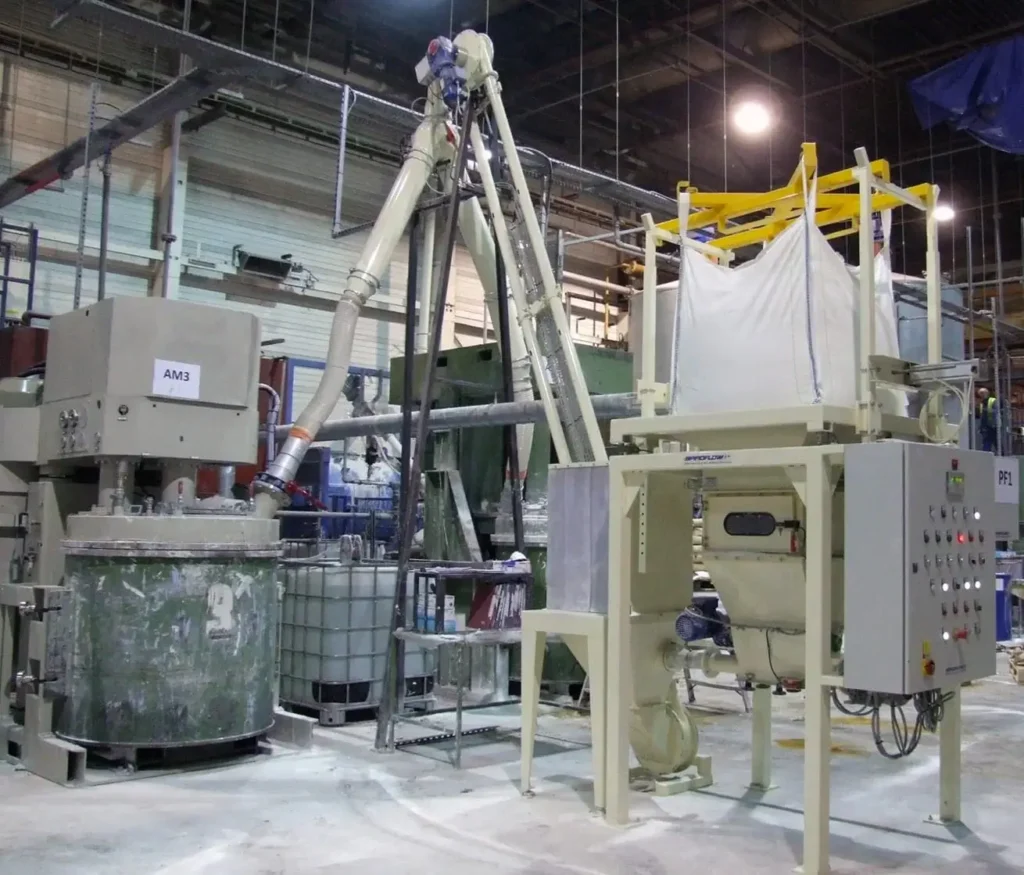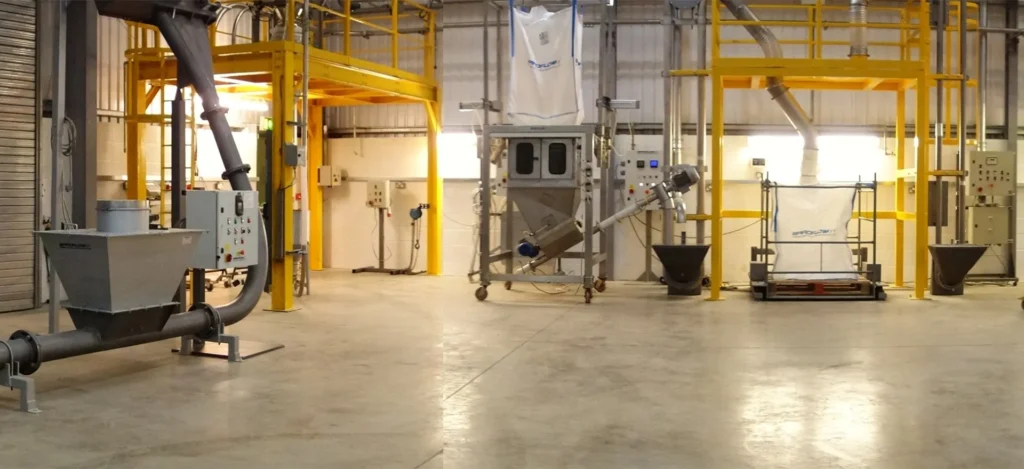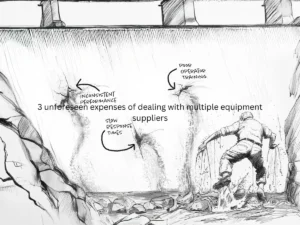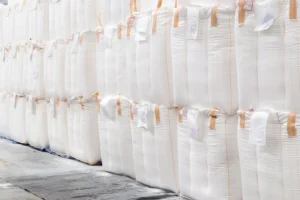In the quest for cleaner, safer industrial environments, designing bulk bag unloaders for maximum dust control emerges as a critical task. This text delves into the innovative engineering practices essential for creating bulk bag unloaders that significantly minimize dust emissions. By prioritizing dust control, manufacturers can enhance workplace safety, comply with regulatory standards, and improve overall operational efficiency.
What Are the Factors to Consider When Designing Bulk Bag Unloaders for Maximum Dust Control?
Controlling dusting and product spillage while safely unloading bulk bags is an industry-wide challenge. Standard, off-the-shelf bulk bag unloaders are often utilized in a new process without a thorough understanding of the nature of the product. This often results in the need for an expensive retrofit assembly after installation and unnecessary commissioning delays. What should be considered to ensure dust-free bulk bag unloading? In the text below, we will talk about the key factors to keep in mind.
The Supplier Specialized for Bulk Bag Unloaders
Specialist suppliers offering bulk bag unloaders for material handling can supply several types of equipment with dust containment options suitable for unloading a variety of materials. Look for a bulk material handling supplier that has experience with the materials you want to unload and has the technical expertise to apply their equipment to the specific requirements of your application.
This normally requires engineered conveyor solutions, with layout drawings, that detail any necessary custom-designed parts to adapt the recommended system to suit your application and location. Experienced suppliers can adapt their equipment for different situations to provide an effective solution.

Material Testing and Bulk Bag Design
Material testing before opting for specific industrial conveyor systems is of utmost importance. Have the supplier test the bulk bag unloader you wish to obtain. This should verify the suitability and dust control capabilities of the equipment for your application. Proper bulk bag selection is one of the most important considerations for dust containment in a bulk bag unloading system.
The bulk bag must contain the fines present in your product – otherwise, particles can sift through the bag fabric. Depending on the amount of fines present in the product, the particle size, and its shape, a coated fabric may be all that is required to contain the dust. If coated fabric doesn’t contain the product fines, polyethylene bulk bag liners can be used to prevent product sifting. Inlet-spouted bags, not open-top bags, should always be used for dusty materials.
Integral Dust Collection, Dust Tight Bag Seating, and Bulk Bag Tensioning
Bulk bag unloaders can be configured with an integral dust collection system. This is an important option for discharging dusty materials. Bulk bag unloaders can also be designed with a port to tie into a plant-wide dust collection system.
Pay attention to how a full bulk bag is installed within the frame of the bulk bag unloader, as this can be a source of unwanted material dusting. In many cases, a dust-tight docking seal built within the base of the bulk bag unloader can significantly help mitigate dusting.
Make sure your bulk bag unloaders are designed to properly tension the bulk bag and any associated liner so that the complete contents of each bag are discharged. Residual material trapped in bag creases and folds can potentially increase dusting and spillage during bag removal.
Additional Factors to Keep in Mind
When implementing bulk bag unloaders in your facility, there are additional factors crucial for achieving maximum dust control beyond the initial design and material considerations. These considerations play a vital role in ensuring a safe, clean, and efficient operation. From the way bulk bags are accessed and emptied to the optimization of downstream processes, each element requires careful thought. In this section, we explore a few advanced strategies.
Enclosed Access Chamber
Nearly half of all spillage and dusting occurs during the bag spout untying process. Controlling dust becomes a much bigger challenge in cases where the product is free-flowing. Look for a bulk bag unloader design where the bag spout access chamber is enclosed and kept under a slight negative pressure to minimize dusting issues and contain spillage. For hazardous material applications, a glove box arrangement, instead of access chamber doors, should be considered to prevent operator exposure.
Sanitary Spout Docking
Positive spout docking arrangements can ensure complete product containment and also allow for efficient bag stretching at the end of the discharge cycle. Consider this design option with or without the access chamber. Efficiently docking a spout can require some skill, and performing this operation in an enclosed area can compensate for operator errors.
‘Empty’ Bulk Bag Removal
Dusting can often occur during the ’empty’ bag removal cycle. It is imperative to tie off the bag spout tightly before bag removal. Consider adding a ‘bag collapsing’ feature that utilizes a dust collector to evacuate the bag and rid the environment of suspended dust. Again, an enclosed access chamber facilitates the capture of any fugitive dust during this step.
Downstream Process Optimization
Allowing sufficient time for the operator to perform each of the necessary steps in the bulk bag unloading process is essential. Planning for strategic time buffers throughout the process can eliminate downtime and allow the operator to properly perform all the necessary operations for a dust-free bulk bag unloading operation!
Contact Spiroflow for Outstanding Bulk Bag Unloaders and Other Conveyor Technologies
If you’re in the market for superior bulk bag unloaders or innovative conveyor solutions, look no further than Spiroflow. Renowned for our bespoke industrial conveyor systems, we excel in creating systems tailored to meet your specific operational needs.
Our expertise spans across various industries, ensuring enhanced efficiency, safety, and productivity in your production processes. With a commitment to quality and customer satisfaction, Spiroflow is your go-to partner for not just meeting but exceeding your material handling requirements. Contact us to discover how our cutting-edge conveyor solutions can transform your business operations.
FAQ
What Are the Key Factors in Designing Dust-Control Bulk Bag Unloaders?
When designing bulk bag unloaders for dust control, key considerations include the material’s characteristics, the unloader’s integration with dust collection systems, and ensuring a dust-tight seal around the bag’s spout. Suppliers with experience in handling similar materials can provide valuable insights and customized conveyor solutions. Testing the product in the proposed unloading system is crucial to verify its effectiveness in controlling dust emissions.
How Can Bulk Bag Design Influence Dust Control?
The design of the bulk bag itself plays a significant role in dust control. Using coated fabric bags or polyethylene liners can prevent fine particles from sifting through the fabric. For handling dusty materials, inlet-spouted bags are preferred over open-top bags, as they help contain dust more effectively.
Why Is Integral Dust Collection Important in Bulk Bag Unloaders?
Integral dust collection systems are essential for managing dust when discharging dusty materials from bulk bags. These systems, whether standalone or part of a plant-wide dust collection system, help to maintain a clean and safe work environment by capturing dust at the source and preventing it from spreading into the surrounding area.
How Do Enclosed Access Chambers and Sanitary Spout Docking Aid in Dust Control?
Enclosed access chambers and sanitary spout docking are innovative features that significantly reduce dust emissions during the bag untying and discharging processes. Enclosing the bag spout access chamber under negative pressure and utilizing a positive spout docking arrangement ensure complete containment of the product and minimize operator exposure to hazardous materials.
What Role Does Downstream Process Optimization Play in Dust-Free Bulk Bag Unloading?
Downstream process optimization, including strategic planning for time buffers and incorporating features like ‘bag collapsing’ to remove residual dust, is crucial for a dust-free bulk bag unloading operation. These measures ensure that each step of the unloading process is conducted efficiently and safely, significantly reducing the risk of dust emissions and enhancing overall operational productivity.






